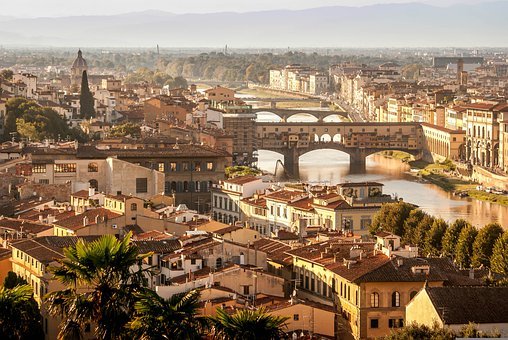ITALY - HISTORY, ART, CULTURE-bilingual almanac
ITALIA - STORIA, ARTE, CULTURE - almanacco bilingue
FLORENCE – FLORENCE
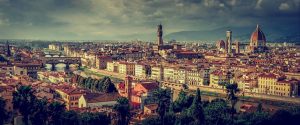 Located on the river Arno, surrounded by hills, with a sky almost always azure, Florence, the capital of the Tuscany region, is one of the most beautiful Italian cities, a veritable museum full of wonderful works of art and historical monuments. Its squares and palaces are adorned with the immortal works of Ghiberti and Brunelleschi, of Cimabue and Giotto, of Michelangelo and Raphael, of Filippo and Botticelli. The names of Dante and Boccaccio, Machiavelli and Galileo, Leonardo da Vinci and Cellini are associated with the history of Florence. Florence was an economic and cultural center during the Renaissance, the great Italian humanists also created their works in Florence, and the literary Italian language was formed here.
Located on the river Arno, surrounded by hills, with a sky almost always azure, Florence, the capital of the Tuscany region, is one of the most beautiful Italian cities, a veritable museum full of wonderful works of art and historical monuments. Its squares and palaces are adorned with the immortal works of Ghiberti and Brunelleschi, of Cimabue and Giotto, of Michelangelo and Raphael, of Filippo and Botticelli. The names of Dante and Boccaccio, Machiavelli and Galileo, Leonardo da Vinci and Cellini are associated with the history of Florence. Florence was an economic and cultural center during the Renaissance, the great Italian humanists also created their works in Florence, and the literary Italian language was formed here.
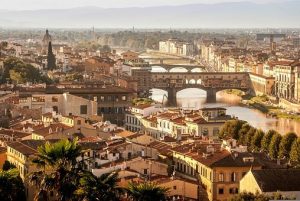 Situata sul fiume Arno, circondata dalle colline con il cielo quasi semper azzurro, Firenze, capoluogo della Toscana, é una delle piú belle cittá italiane, un vero museo, pieno di bellissime opera d'arte e di monuments storici. Its piazzas and palaces are decorated with immortal works by Ghiberti and Brunelleschi, by Cimabue and Giotto, by Michelangelo and Raphael, by Filippo and Botticelli. The names of Dante and Bocaccio, Machiavelli and Gallileo, Leonardo da Vinci and Cellini are all linked to the history of Florence. Firenze was an economic and cultural center of the Renaissance, and Firenze creavano le loro opera e grandi umanisti italiani, qui si formó la lingua italiana literaria.
Situata sul fiume Arno, circondata dalle colline con il cielo quasi semper azzurro, Firenze, capoluogo della Toscana, é una delle piú belle cittá italiane, un vero museo, pieno di bellissime opera d'arte e di monuments storici. Its piazzas and palaces are decorated with immortal works by Ghiberti and Brunelleschi, by Cimabue and Giotto, by Michelangelo and Raphael, by Filippo and Botticelli. The names of Dante and Bocaccio, Machiavelli and Gallileo, Leonardo da Vinci and Cellini are all linked to the history of Florence. Firenze was an economic and cultural center of the Renaissance, and Firenze creavano le loro opera e grandi umanisti italiani, qui si formó la lingua italiana literaria.
In the center of the city is the Duomo Square with famous monuments: the Cathedral of Santa Maria del Fiore, Giotto's Bell Tower and the Baptistery (a room in the church or an annex to it (from the south), where in the first centuries of the recognition of Christianity as an official religion and in the Middle Ages the ritual of holy baptism of adults was performed) with its bronze-decorated gate by Lorenzo Ghiberti, called by Michelangelo the "Gate of Heaven" because of its beauty. Florence is home to the two richest galleries: the Galleria deli Uffizi and the Galleria Pitti, which house the works of some of the most famous art masters. The two arms of the Arno are connected by numerous bridges, but the oldest and most interesting is the Ponte Vecchio (old bridge), which has preserved its medieval appearance with its small shops.
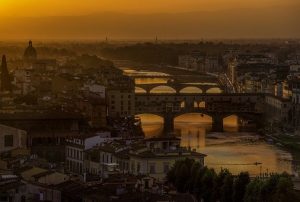 In the center of the city is the piazza del Duomo with the famous monuments: the cathedral Santa Maria del Fiore, the Campanile di Giotto and the Baptistery with the magnificent door of bronze gold, work of Lorenzo Ghiberti, called by Michelangelo the "Porta del paradiso ” per la sua bellezza. And Florence has two rich galleries: Galleria degli Uffizi and Galleria Pitti con le opera dei piú grandi artisti italiani. Le due rive dell'Arno sono legate da numeros ponti, ma il piú antico e interesante é il Ponte vecchio, che ha conservato il suo aspetto medioevale con piccole botteghe.
In the center of the city is the piazza del Duomo with the famous monuments: the cathedral Santa Maria del Fiore, the Campanile di Giotto and the Baptistery with the magnificent door of bronze gold, work of Lorenzo Ghiberti, called by Michelangelo the "Porta del paradiso ” per la sua bellezza. And Florence has two rich galleries: Galleria degli Uffizi and Galleria Pitti con le opera dei piú grandi artisti italiani. Le due rive dell'Arno sono legate da numeros ponti, ma il piú antico e interesante é il Ponte vecchio, che ha conservato il suo aspetto medioevale con piccole botteghe.
SIGHTS OF FLORENCE – DA VEDERE A FIRENZE
Cathedral of Santa Maria del Fiore or Duomo. A Gothic cathedral with Filippo Brunelleschi's amazing dome, which you must climb for an incredible view from above the city.
Cattedrale di Santa Maria del Fiore o Duomo. Una cattedrale gotica con l'incredibile cupola di Filippo Brunelleschi, che devi salire per un'incredibile vista dall'alto della città.
The Church of Santa Maria Novella. Here you can admire the masterpieces of Masaccio, Giotto, Brunelleschi and others.
La Chiesa di Santa Maria Novella. Qui si possono admire the masterpieces of Masaccio, Giotto, Brunelleschi and others.
The Basilica of Santa Croce. Beautiful works of art, including Giotto's frescoes. It contains the monumental tombs of Galileo Galilei, Michelangelo, Machiavelli, Dante and others.
The Basilica di Santa Croce. Splendide opere d'arte, tra cui gli affreschi di Giotto. It contains the monumental tombs of Galileo Galilei, Michelangelo, Machiavelli, Dante and others.
The Basilica of Santo Lorenzo. A sumptuous square-shaped ancient temple designed by Brunelleschi. The new part of the temple was made by Michelangelo.
The Basilica di Santo Lorenzo. A sumptuous ancient temple of square shape designed by Brunelleschi. The new part of the temple was made by Michelangelo.
Brancacci Chapel or Santa Maria del Carmine - famous for its frescoes by Masaccio. The visit now also includes an excellent interactive tour of the building.
Cappella Brancacci o Santa Maria del Carmine – famous for its paintings by Masaccio. The visit now includes an excellent interactive tour of the building.
Uffizi Gallery. One of the best museums in the world, with masterpieces from the 13th to the 19th century.
Uffizi Gallery. Uno dei migliori musei del mondo, con masterpieces dal XIII al XIX secolo.
Gallery of the Academy. Famous sculptors from Michelangelo are exhibited here, including the incredible "David".
Galleria dell'Accademia. Qui sono exposito famosi scultori di Michelangelo, tra cui l'incredibile "David".
Palazzo Vecchio. Literally, Palazzo Vecchio means the Old Palace. It is the home of the Medici and was also the Chamber of Deputies.
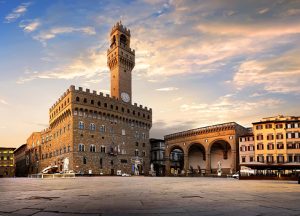
Palazzo Vecchio. È la residence dei Medici ed è stata anche Camera dei Deputati.
Palazzo Pitti and the Boboli and Bardini Gardens. Residence of the Pitti family, rivals of the Medici. The Boboli and Bardini gardens are in front of the palace.
Palazzo Pitti and Giardini di Boboli and Bardini. Residenza della famiglia Pitti, rivals dei Medici. In front of the palazzo are the Boboli and Bardini gardens.
Dante's House and Museum. This is not the house where Dante was born, but the writer lived here (or very close by).
Casa e Museo di Dante. Questa non è la casa natale di Dante, ma lo scrittore visse qui (o molto vicino).
Ponte Vecchio is a covered bridge over the Arno River in Florence, Italy. It is known mainly for the jewelry stores built on it. The bridge is located between the Uffizi Gallery and the Pitti Palace. There was a bridge at this place as early as the end of the Roman Empire (4th century). It acquired its present appearance in 1345. In the middle of the bridge there is a bust of Benvenuto Cellini. There, lovers have the custom of leaving a padlock, the key of which they throw into the river, so that their love will last forever.
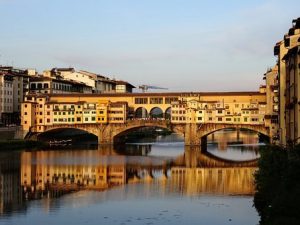 Ponte Vecchio is a covered bridge on the river Arno in Florence, Italy. È noto principally per le gioiellerie costruite su di esso. Il ponte si trova between the Galleria degli Uffizi and Palazzo Pitti. In questo luogo esisteva un ponte già alla fine dell'Impero Romano (IV secolo). It was acquired in its current form in 1345. In the center of the bridge is a bust of Benvenuto Cellini. Lì gli innamorati hanno l'usanza di lasciare un lucchetto, la cui chiave gettano nel fiume, perché il loro amore duri per semper.
Ponte Vecchio is a covered bridge on the river Arno in Florence, Italy. È noto principally per le gioiellerie costruite su di esso. Il ponte si trova between the Galleria degli Uffizi and Palazzo Pitti. In questo luogo esisteva un ponte già alla fine dell'Impero Romano (IV secolo). It was acquired in its current form in 1345. In the center of the bridge is a bust of Benvenuto Cellini. Lì gli innamorati hanno l'usanza di lasciare un lucchetto, la cui chiave gettano nel fiume, perché il loro amore duri per semper.
Campanile di Giotto - Giotto's bell tower is a tower of the Church of Our Lady of the Flowers, a cathedral in Florence, located in Piazza Duomo. Il campanile di Giotto is the bell tower of Santa Maria del Fiore, the cathedral of Florence, and is located in piazza del Duomo. The tower played an important role in the life of medieval Florence. From the very beginning, it was to serve as a symbol of majesty, military power and the independence of the city. The bell tower of Santa Maria del Croce, one of the most beautiful in Italy, was built according to Giotto's plans, and its function was always rather decorative. In 1334, the architect was chosen to continue the construction of the church, which had been suspended for 30 years. Although he adhered to the already existing construction plans, Giotto decided to put in something of his own – so he built the bell tower according to his own vision. He began work in 1334 and worked until 1337, the year of his death. In the end, Giotto managed to see only the first floor of his creation in its finished form. The artists previously directed by Giotto continued and completed his project.
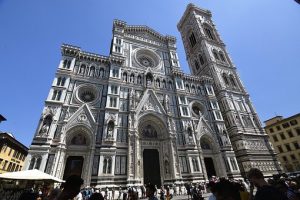 Campanile di Giotto – Il campanile di Giotto is a tower of the Church of the Madonna dei Fiori, cathedral of Florence, situated in Piazza Duomo. Il campanile di Giotto is the campanile of Santa Maria del Fiore, the cathedral of Florence, and it is located in piazza del Duomo. The tower played an important role in the life of medieval Firenze, at the end of the beginning it was a symbol of majesty, military power and independence of the city. Il campanile di Santa Maria del Croce, uno dei più belli d'Italia, was built to Giotto's design, and its function was always quite decorative. In 1334 the architect was chosen to continue the construction of the church, suspended for 30 years. Although he adhered to the already existing construction plans, Giotto decided to insert something of his own, so he built the campanile according to his vision. He started working in 1334 and worked until 1337, the year of his death. Alla fine, Giotto è managed to see solo il primo piano della sua creazione nella sua finita. The artists previously directed by Giotto continued and completed his project.
Campanile di Giotto – Il campanile di Giotto is a tower of the Church of the Madonna dei Fiori, cathedral of Florence, situated in Piazza Duomo. Il campanile di Giotto is the campanile of Santa Maria del Fiore, the cathedral of Florence, and it is located in piazza del Duomo. The tower played an important role in the life of medieval Firenze, at the end of the beginning it was a symbol of majesty, military power and independence of the city. Il campanile di Santa Maria del Croce, uno dei più belli d'Italia, was built to Giotto's design, and its function was always quite decorative. In 1334 the architect was chosen to continue the construction of the church, suspended for 30 years. Although he adhered to the already existing construction plans, Giotto decided to insert something of his own, so he built the campanile according to his vision. He started working in 1334 and worked until 1337, the year of his death. Alla fine, Giotto è managed to see solo il primo piano della sua creazione nella sua finita. The artists previously directed by Giotto continued and completed his project.

